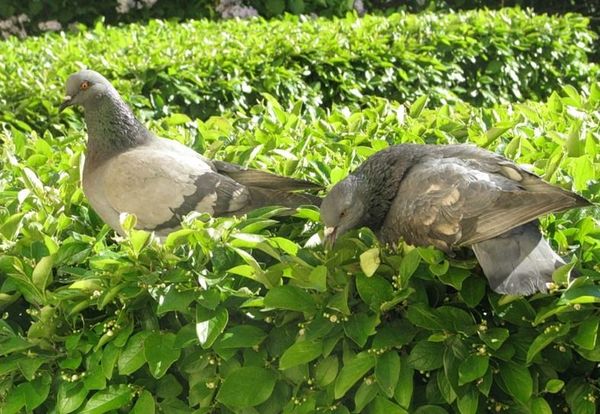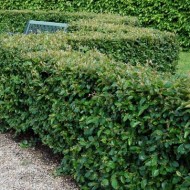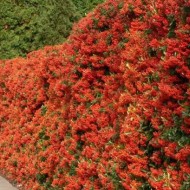Brilliant cotoneaster in the garden: the intricacies of creating the perfect hedge
Content
- 1 Characteristics and description of the variety
- 2 Video "A hedge from a brilliant cotoneaster"
- 3 Advantages and disadvantages
- 4 Landing features
- 5 Rules for caring for a brilliant cotoneaster
- 6 Pests and diseases of the brilliant cotoneaster
- 7 How to propagate an ornamental shrub
- 8 Cotoneaster brilliant in landscape design
Characteristics and description of the variety
A self-sufficient beautiful garden that requires a minimum of maintenance is the object of desire of all summer residents. At the same time, I want to stand out against the background of the usual rose gardens and vines. The extensive genus of cotoneaster contains several dozen species, and at least ten of them can be successfully used to decorate and arrange a garden.

A native of Asia, an unpretentious long-liver belongs to the Rosaceae family. The cotoneaster has a dense, abundantly leafy crown. Shoots grow straight, the height under natural conditions is about 2 m. Leaves are glossy, small, deep green, ovoid, slightly pointed towards the outer edge.
A feature of the variety is the ability to change color from bright green in early spring to purple in autumn.
The shrub blooms in late spring or early summer. Inflorescences are corymbose, combine from 4 to 8 pink buds. When the flowers open, the effect of the combination of bright foliage and delicate blush gives the bush an unusually attractive decorative look.
Almost every flower produces berries that also change color during ripening: green, red, black. And although the fruits of this type are small, they can be eaten.
The bush grows rather slowly, but at the same time it is completely unpretentious in care, undemanding to the composition of the soil and lighting, it calmly tolerates severe cold, frost and drought. And due to its immunity to gas pollution of air and dust, it can calmly grow in the road area.
Video "A hedge from a brilliant cotoneaster"
In this video, you will learn what a hedge from a brilliant cotoneaster looks like.
Advantages and disadvantages
The brilliant cotoneaster has a number of advantages, which greatly increases its chances of being chosen by gardeners. And not only as a hedge. Craftsmen often carve various abstractions and shapes from a pliable plant.
- calmly tolerates temperature extremes, high and low rates;
- unpretentious to the structure of the soil;
- tolerates drought well;
- has a low risk of diseases and pests;
- undemanding to lighting, which allows you to grow it in any area of the garden.
- the need to regularly prune the shrub;
- some difficulties in the breeding process.
According to gardeners' reviews, we can conclude that the cotoneaster looks great as a hedge and without regular pruning.
Landing features
The shrub is calm about changing places, tolerates transplanting almost painlessly and adapts to new soil. However, you should not risk it and it is better to wait with a transplant or planting until spring comes and the soil warms up.

Site selection and soil preparation
Although the cotoneaster is undemanding to lighting, it is recommended to choose a well-lit place for planting. Light shading will not be a hindrance, but constant shade will not allow the shrub to grow luxuriantly. The plant does not tolerate drafts and strong gusts of wind, so it is better to choose a cozy, protected place.
Since the depth of the pit must be at least 50 cm, you also need to focus on the depth of the groundwater deposits. But in any case, it is better to lay out the drainage layer at the bottom of the hole.
The composition of the soil does not play a decisive role, but a properly fertilized soil will provide the shrub with all the necessary nutrients for growth and development.
The soil is prepared from the following components: turf, peat or compost and coarse sand. Turf and sand are mixed in equal amounts, and peat should be only ½ of any of these ingredients.
Adding lime at the rate of 300 g per 1 m² will also be advisable.
General landing rules
- The planting time depends on the type of seedlings: if the seedlings are with closed roots, then they can be planted from early spring to late autumn. If the roots are open - end of March and April or September and October.
- The number of bushes per 1 m² (depending on the purpose of planting): for a high hedge - up to 3, for a low hedge - 4–5. The checkerboard pattern assumes a distance of 40-50 cm.
- The pit should be between half a meter and 70 cm deep and a similar width.
- A drainage layer is laid out at the bottom of the pit: broken brick, pebbles, gravel.
Rules for caring for a brilliant cotoneaster
The mild climate with warm winters and sufficient rainfall reduces the number of necessary agrotechnical measures.
Watering and soil care
The brilliant cotoneaster is a drought-resistant plant, so do not overuse watering. Waterlogging can kill the plant. If there is a sufficient amount of sediment, there is no need to water the shrub at all. In case of prolonged drought, the plant is watered every 2 weeks. For one bush, 8 liters of water is enough.
Top dressing and fertilization
A beautiful, abundant crown and strong shoots require nitrogen-containing fertilizers. Before flowering, potassium-phosphate complexes are introduced. It is recommended to combine fertilization with watering for better assimilation. Also, do not ignore organic matter, you can use both humus and manure.
Shrub shearing
You will need special trellis shears or a brush cutter to trim the shrub. Usually the cotoneaster is pruned several times a year. There are some general rules for cutting a plant:
- it is necessary to form a crown only when the growth of the bush is at least half a meter;
- in the spring, sanitary pruning is mandatory;
- first of all, the bush is pinched from above to stimulate the growth of shoots;
- young branches are cut by no more than ⅓;
- autumn seedlings do not need pruning before the dormant period.
Various shapes are cut using a template or stretched ropes.
Preparing for winter
The brilliant cotoneaster is quite frost-resistant, but the harsh winters require shelter of the bush. To cover the plant, you can use spruce branches, peat or a special covering material - spunbond. Shoots that are too tall are bent to the ground to keep the buds warm.
Pests and diseases of the brilliant cotoneaster
The culture has a strong immunity to disease. Therefore, if you avoid waterlogging, then the risk of their appearance is very low.If Fusarium nevertheless struck the bush, then you need to immediately treat it with a fungicide, and cut off the affected areas completely, to healthy tissue.
However, pests can occasionally appear on the bush: scale insects, aphids, spider mites or moths. Therefore, it is better to prophylactically treat the shrub with insecticides. Only two treatments, and there is no need to fear for the health of the plant.

How to propagate an ornamental shrub
The most convenient way to plant annuals, however, you can propagate the bush in other ways.
Seeds
To obtain seeds, the fruits must be freed from the pulp and dried. Then collect the seeds, which must be soaked in water before planting. Those that float are unsuitable for landing. Seeds are sown at a distance of 15 cm, depth - 4 cm. Germination can take about a year.
After germination, it will take another year for the seedling to grow to 30 cm.
Layers
Long shoots that hang almost to the ground (10 cm) can be bent to the ground and pinned. Then the plant is covered with fertile soil. When the layering takes root, you can cut off the shoot from the main bush.
Cuttings
Healthy shoots, from 15 cm in length with several internodes, are great for cutting. The cutting is preliminarily placed in a solution of a growth stimulant, and then planted in the soil mixture at an angle of 45 °. Then the cutting is covered with a glass container, which is removed daily to ventilate the seedling. After rooting, the cutting is planted in a permanent place.

Cotoneaster brilliant in landscape design
From the cotoneaster, you can create hedges, curly compositions and use them for zoning space.
Accommodation options
Along with a straight one-row hedge, you can also find a checkerboard arrangement of bushes. Often cotoneaster plants are planted in groups, forming green oases and islets. If a live composition is planned, then the bushes are planted according to the template scheme.
How to trim a hedge
The most effective method is to pull two parallel ropes at the correct height along the entire length of the fence. Thus, the height of the rope will serve as a reference point below which one should not go down.
We advise you to be sure to familiarize yourself with the characteristics of the cotoneaster: an ensemble of glossy fruits and berries, a changing color and gentle flowering will favorably distinguish your hedge from the usual ones.



